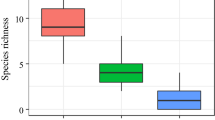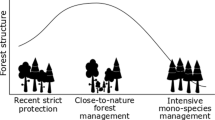Abstract
-
• Stand structure indices would appear to be good surrogate measures for biodiversity in forest ecosystems.
-
• The vertical structure of Pinus sylvestris L. stands in Central Spain was analysed in order to evaluate their structural diversity. A comparison between two forests with similar ecological conditions but managed under different silvicultural systems was conducted in order to analyse changes in diversity at different stages of stand development. Height diversity was quantified using two non-spatially explicit indices (Shannon’s index and STVI) as well as two spatially explicit indices (Gadow’s differentiation index and the Structure complexity index). A new diversity index was then proposed, based on the sum of square roots of height differences (SQRI).
-
• Correlations between all vertical structure indices were highly significant. All indices showed that height diversity was greater in the forest with the longer regeneration period and where less intensive thinnings were applied throughout the rotation. Diversity was highest in uneven-aged stands and in the period between the regeneration stage and the first thinning. Thinning from below accounted for the decrease in vertical structure complexity throughout the rotation in even-aged stands.
-
• The results show that height distribution along with successional stage data enhance the analysis of vertical diversity since structural complexity is highly related to the silvicultural practices that are carried out at different ages.
Résumé
-
• Les indices de structure de peuplements semblent être de bonnes mesures de substitution pour l’estimation de la biodiversité dans les écosystèmes forestiers.
-
• La structure verticale des peuplements de Pinus sylvestris L. dans le centre de l’Espagne a été analysée afin d’évaluer leur diversité structurelle. Une comparaison entre deux forêts, ayant des conditions écologiques similaires mais gérées avec une sylviculture différente, a été réalisée afin d’analyser les changements dans la diversité à différents stades de développement du peuplement. La diversité de hauteur a été quantifiée au moyen de deux indices non-spatialement explicites (indice de Shannon et STVI) ainsi que de deux indices spatialement explicites (l’Indice de différenciation Gadow et l’Index de complexité de structure). Un nouvel indice de la diversité, basé sur la somme des carrés des racines des différences de hauteur (SQRI), a ensuite été proposé.
-
• Les corrélations entre les indices de structure verticale sont très significatives. Tous les indices montrent que la diversité en hauteur est plus grande dans la forêt ayant la plus longue période de régénération et là où les éclaircies les moins intensives ont été appliquées dans l’ensemble de la rotation. La diversité est la plus élevée dans les peuplements inéquiennes et dans la période entre la phase de régénération et la première éclaircie. L’éclaircie par le bas représente la diminution de complexité de la structure verticale dans l’ensemble de la rotation, dans les peuplements équiennes.
-
• Les résultats montrent que la distribution des hauteurs avec les données des stades de succession améliore l’analyse de la diversité verticale puisque la complexité structurelle est fortement liée à la sylviculture qui a été réalisée à des âges différents.
Similar content being viewed by others

References
Aguirre O., Hui G., Gadow K.V., and Jiménez J., 2003. An analysis of spatial forest structure using neighbourhood-based variables. For. Ecol. Manage. 183: 137–145.
Berger A. and Puettmann K.J., 2000. Overstory composition and stand structure influence herbaceous plant diversity in the mixed aspen forest of northern Minnesota. Am. Midl. Nat. 143: 111–125.
Buongiorno J., Dahir S., Lu H.C., and Lin C.R., 1994. Tree size diversity and economic returns in uneven-aged forest stands. For. Sci. 40: 83–103.
Camarero J.J., Gutiérrez E., Fortin M.J., and Ribbens, E. 2005 Spatial patterns of tree recruitment in a relict population of Pinus uncinata: forest expansion through stratified diffusion. J. Biogeogr. 32: 1979–1992.
Coates, K.D. and Steventon J.D., 1995. Patch retention harvesting as a technique for maintaining stand level biodiversity in forests of north central British Columbia. In: Bamsey S.R. (Ed.), Innovative silviculture systems in Boreal forests, Proc. IUFRO Symp. in Edmonton, Alberta, Canada, 2–8 October 1994, pp. 102–106.
Dale M.R.T., 1999. Spatial pattern analysis in plant ecology, Cambridge University Press, Cambridge, 326 p.
FAO, 1989. Carte mondiale des sols — légende révisée, FAO, Rapport sur les ressources en sols du monde, No. 60, Rome.
Degraaf R.M., Hestbeck J.B., and Yamasaki, M., 1998. Associations between breeding bird abundance and stand structure in the white mountains, New Hampshire and Maine, USA. For. Ecol. Manage. 103: 217–233.
Ferris-Kaan R., Peace A.J., and Humphrey, J.W., 1998. Assesing structural diversity in managed forests. In: Bachmann, P. (Ed.), Assesment of biodiversity for improved forest planning, European Forest Institute Proceedings, 18, Kluwer Academic Publishers, Dordrecht, the Netherlands, pp. 331–342.
Forteza J., Lorenzo L.F., Najac N., Cuadrado S., Ingelmo F., Hernández J., García M.P., Prat L., Muñez M.C., Macarro M.C., Rivas M.D., and García, A., 1988. Mapa de suelos de Castilla León, escala 1:500 000, Consejería de Fomento, Junta de Castilla y León, Valladolid.
Franklin J.F., Spies, T.A., Pelt R.V., Carey A.B., Thornburgh D.A., Berg D.R., Lindenmayer D.B., Harmon M.E., Keeton W.S., Shaw D.C., Bible K., and Chen J., 2002. Disturbances and structural development of natural forest ecosystems with silvicultural implications, using Douglas-fir forests as an example. For. Ecol. Manage. 155: 399–423.
Fraser A.R. and van den Driessche, P., 1971. Triangles, density, and pattern in plant point populations. In: Proceedings of the 3rd conference Advisory Group of Forest Statisticians, Int. Union. For Res. Organ., Inst. Nat. Rech. Agric., Jouy-en-Josas, France, pp. 277–286.
Gadow K.V., 1993. Zur Bestandesbeschreibung in der Forsteinrichtung. Forst und Holz 21: 601–606.
Gadow K.V. and Hui G., 1999. Modelling forest development, Kluwer academic publishers, Dordrecht, the Netherlands, 213 p.
Grassi G., Minotta G., Tonon G., and Bagnaresi U., 2004. Dynamics of Norway spruce and silver fir natural regeneration in a mixed stand under uneven-aged management. Can. J. For. Res. 34: 141–149.
Hansen A.J., Spies T.A., Swanson F.J., and Ohmann J.L., 1991. Conserving biodiversity in managed forests: lessons from natural forests. Bioscience 41: 382–392.
Jaehne S. and Dohrenbush A., 1997. Ein Verfahren zur Beurteilung der Bestandesdiversität. Summary: A method to evaluate forest stand diversity. Forstw. Cbl. 116: 333–345.
Kimming J.P., 1997. Biodiversity and its relationship to ecosystem health and integrity. For. Chron; 73: 229–232.
Kint V., 2005. Structural development in ageing temperate Scots pine stands. For. Ecol. Manage. 214: 237–250.
Kuuluvainen T., Penttinen A., Leionen K., and Nygren M., 1996. Statistical opportunities for comparing stand structural heterogeneity in managed and primeval forests: an example from boreal Spruce forest in southern Finland. Silva Fenn. 30: 315–328.
Lähde E., Laiho O., and Norokorpi Y., 1999. Diversity-oriented silviculture in the boreal zone of Europe. For. Ecol. Manage. 118: 223–243.
LeMay V. and Staudhammer C., 2005. Indices of stand structural diversity: adding spatial diversity to a stand structural index. Extended abstract. In: Proceedings of the IUFRO Sustainable Forestry in Theory and Practice: Recent Advances in Inventory and Monitoring Conference, Edinburgh, Scotland.
Loftis D.L., 1990. A Shelterwood method for regenerating red oak in the southern Appalachians. For. Sci. 36: 917–929.
MacArthur R.M. and Mac Arthur J.W., 1961. On bird species diversity. Ecology 42: 594–598.
Magurran A.E., 1988. Ecological diversity and its measurement, Princeton University Press, Princeton, New Jersey, 179 p.
Mason W.L. and Alía R., 2000. Current and future status of Scots pine (Pinus sylvestris L.) forests in Europe, Investigación Agraria, Sistemas y recursos forestales, Fuera de serie No. 1: 318–333.
Miller T.F., Mladenoff D.J., and Clayton M.K., 2002. Old-growth northern hardwood forests: spatial autocorrelation and patterns of under-story vegetation. Ecol. Monogr. 72: 487–503.
Moen C.A. and Gutiérrez R.J., 1997. California spotted owl habitat selection in the central Sierra Nevada. J. Wild. Manage. 61: 1281–1287.
Montes F., Cañellas I., Río M.d., Calama R., and Montero G., 2004. The effects of thinning on the structural diversity of coppice forests. Ann. For. Sci. 61: 771–779.
Montes F., Sánchez M., Río M.d., and Cañellas I., 2005. Using historic management records to characterize the effects of management on the structural diversity of forests. For. Ecol. Manage. 207: 279–293.
Montes F., Pita P., Rubio A., and Cañellas I., 2007. Leaf area index estimation in mountain even-aged Pinus silvestris L. stands from hemispherical photographs. Agric. For. Meteorol. 145: 215–228.
Montes F., Barbeito I., Rubio A., and Cañellas I., 2008. Evaluating height structure in Scots pine forests using marked point processes. Can. J. For. Res. 38: 1924–1934.
Neumann M. and Starlinger F., 2001. The significance of different indices for stand structure and diversity in forest. For. Ecol. Manage. 145: 91–106.
North M.P., Franklin J.F., Carey A.B., Forsman E.D., and Hamer T., 1999. Forest stand structure of the northern spotted owl’s foraging habitat. For. Sci. 45: 520–527.
O’Hara K.L., Hasenauer H., and Kindermann G., 2007. Sustainability in multi-aged stands: an analysis of long-term plenter systems. Forestry 80: 163–181.
Pretzsch H., 1995. Zum Einfluss des Baumverteilungsmusters auf den Bestandeszuwachs. Allg. Forst-u. J. Ztg. 166: 190–201.
Pretzsch H., Utschig H., and Sodtke R., 2006. Applications of tree growth modelling in decision support for sustainable forest management. In: Hasenauer H. (Ed.), Sustainable forest management: growth models for Europe, Springer Verlag, Berlin Heidelberg, pp. 131–149.
Pommerening A. and Stoyan D., 2006. Edge-correction needs in estimating indices of spatial forest structure. Can. J. For. Res. 36: 1723–1739.
Recher H.F., Majer J.D., and Ganesh S., 1996. Eucalyptus, arthropods and birds: on the relation between foliar nutrients and species richness, For. Ecol. Manage. 85: 177–195.
SAS Institue Inc., SAS OnlineDoc®. Version 9.1.3, SAS Institute Inc., Cary, USA, 2004.
Shannon C.E., 1949. The mathematical theory of communication. In: Shannon C.E. and Weaver W. (Eds.), The mathematical theory of communication, University of Illinois Press, Urbana, IL, pp. 29–125.
Staudhammer C.L. and LeMay V.M., 2001. Introduction and evaluation of possible indices of stand structural diversity. Can. J. For. Res. 31: 1105–1115.
Sterba H., 2008. Diversity indices based on angle count sampling and their interrelationships when used in forest inventories. Forestry 81: 587–597.
Swanson F.J. and Franklin J.F., 1992. New forestry principles from ecosystem analysis of pacific Northwest forests. Ecol. Appl. 3: 262–274.
Varga P., Chen H.Y.H., and Klinka K., 2005. Tree-size diversity between single- and mixed-species stands in three forest types in western Canada. Can. J. For. Res. 35: 593–601.
Zenner E. and Hibbs D., 2000. A new method for modelling the heterogeneity of forest structure. For. Ecol. Manage. 129: 75–87.
Zenner E., 2004., Does old-growth condition imply high live-tree structural complexity? For. Ecol. Manage. 195: 243–258.
Zenner E., 2005. Investigating scale-dependent stand heterogeneity with structure-area-curves. For. Ecol. Manage. 209: 87–100.
Weber J., 2000. Geostatistische analyse der struktur von waldbeständen am beispiel ausgewählter Bannwälder in Baden-Württemberg. Berichte freiburger forstliche forschung Heft 20, FVA Baden-Württemberg, Freiburg, 133 p.
Author information
Authors and Affiliations
Corresponding author
Rights and permissions
About this article
Cite this article
Barbeito, I., Cañellas, I. & Montes, F. Evaluating the behaviour of vertical structure indices in Scots pine forests. Ann. For. Sci. 66, 710 (2009). https://doi.org/10.1051/forest/2009056
Received:
Revised:
Accepted:
Issue Date:
DOI: https://doi.org/10.1051/forest/2009056



